Numerical Study on Nitrogen Oxide and Black Carbon Reduction of Marine Diesel Engines Using Emulsified Marine Diesel Oil
Abstract
1. Introduction
2. Research Method
2.1. Experiment Method
2.2. Numerical Analysis Method
3. Results and Investigations
3.1. Combustion Characteristic of Emulsified Marine Diesel Oil
3.2. Specific Fuel Consumption Characteristic with Emulsified and Marine Diesel Oil
3.3. NOx and Black-Carbon Reduction Characteristic with Emulsified and Marine Diesel Oil
4. Conclusions
Author Contributions
Acknowledgments
Conflicts of Interest
References
- Hsu, A.; Esty, D.C.; Levy, M.A.; de Sherbinin, A. 2016 Environmental Performance Index (EPI). Yale Center for Environmental Law and Policy (YCELP) and Center for International Earth Science Information Network (CIESIN). 2016. Available online: https://www.researchgate.net/publication/309417857_2016_Environmental_Performance_Index_EPI (accessed on 4 November 2019). [CrossRef]
- Namioka, T.; Yoshikawa, K.; Takeshita, M.; Fujiwara, K. Commercial-scale demonstration of pollutant emission reduction and energy saving for industrial boilers by employing water/oil emulsified fuel. Appl. Energy 2012, 93, 517–522. [Google Scholar]
- Barnaud, F.; Schmelzle, P.; Schulz, P. AQUAZOLE™: An Original Emulsified Water-Diesel Fuel for Heavy-Duty Applications. In SAE Technical Paper Series; 2000-01-1861; SAE: Warrendale, PA, USA, 2000. [Google Scholar]
- Alahmer, A. Influence of using emulsified diesel fuel on the performance and pollutants emitted from diesel engine. Energy Convers. Manag. 2013, 73, 361–369. [Google Scholar] [CrossRef]
- Subramanian, K. A comparison of water–diesel emulsion and timed injection of water into the intake manifold of a diesel engine for simultaneous control of NO and smoke emissions. Energy Convers. Manag. 2011, 52, 849–857. [Google Scholar] [CrossRef]
- Kadota, T.; Yamasaki, H. Recent advances in the combustion of water fuel emulsion. Prog. Energy Combust. Sci. 2002, 28, 385–404. [Google Scholar] [CrossRef]
- Tarlet, D.; Bellettre, J.; Tazerout, M.; Rahmouni, C. Prediction of micro-explosion delay of emulsified fuel droplets. Int. J. Therm. Sci. 2009, 48, 449–460. [Google Scholar] [CrossRef]
- MEPC. 66/6/Consideration and Adoption of Amendments to Mandatory Instruments. In Comments to the Approval at MEPC 65 of Amendments to the Effective Date of the NOx Tier III Standards; MEPC: Marshall Islands, Norway, 2013. [Google Scholar]
- International Organization for Standards. Petroleum Products-Fuels (Class F)-Specifications of Marine Fuels; International standard, ISO 8217:2012(E); ISO: Geneva, Switzerland, 2012. [Google Scholar]
- Park, S.; Woo, S.; Kim, H.; Lee, K. The characteristic of spray using diesel water emulsified fuel in a diesel engine. Appl. Energy 2016, 176, 209–220. [Google Scholar] [CrossRef]
- Ariana, I.M.; Nishida, O.; Fujita, H.; Harano, W.; Fujio, M. Removal of Marine Diesel Particulate Matter by Electrostatic Precipitator, ICESP X. Australia. Paper 4A2. 2006. Available online: http://www.isesp.org/ICESP X PAPER S/PDFS/Paper 4A2.pdf (accessed on 20 April 2018).
- Farnoud, A. Electrostatic Removal of Diesel Particulate Matter. Ph.D. Thesis, Southern Methodist University, Dallas, TX, USA, 2008. [Google Scholar]
- Hayashi, H.; Kimura, M.; Kawahara, K.; Takasaki, Y.; Takashima, K.; Mizuno, A. Collection of Diesel Exhaust Particle Using Electrostatic Charging Prior to Mechanical Filtration. In Proceedings of the Electrostatics Joint Conference, Boston, MA, USA, 16–18 June 2009. [Google Scholar]
- Kawakami, H.; Zukeran, A.; Yasumoto, K.; Inui, T.; Ehara, Y.; Yamamoto, T. Diesel PM Collection for Marine Emissions Using Double Cylinder Type Electrostatic Precipitator. Int. J. Plasma Environ. Sci. Technol. 2011, 5, 174–178. [Google Scholar]
- Yamamoto, T.; Mimura, T.; Otsuka, N.; Ito, Y.; Ehara, Y.; Zukeran, A. Diesel PM Collection for Marine and Automobile Emissions Using EHD Electrostatic Precipitators, Industry Applications. IEEE Trans. Ind. Appl. 2010, 46, 1606–1612. [Google Scholar] [CrossRef]
- Corbett, J.; Winebrake, J.; Green, E. An assessment of technologies for reducing regional short-lived climate forcers emitted by ships with implications for Arctic shipping. Carbon Manag. 2010, 1, 207–225. [Google Scholar] [CrossRef]
- Coroller, P.; Plassat, G.; Seguelong, T. Comparative Study on Exhaust Emissions from Dieseland CNG-Powered Urban Buses. In Proceedings of the Diesel Engine Emissions Reduction (DEER) Conference, Newport, RI, USA, 24 August 2003. [Google Scholar]
- EmiNO, CRT System Operation and Maintenance Manual. 2011. Available online: http://www.emiNOx.com/assets/documents-and-downloads/EnglishCRT manualLR.pdf (accessed on 12 March 2016).
- Lowell, D. Comparison of Clean Diesel Buses to CNG Buses. In Proceedings of the Diesel Engine Emissions Reduction (DEER) Conference, Newport, RI, USA, 24 August 2003; Available online: https://www.energy.gov/sites/prod/files/2014/03/f9/deer_2003_lowell.pdf (accessed on 12 August 2003).
- US-EPA. Diesel Particulate Filter General Information. United States Environmental Protection Agency Technical Bulletin: 2010. Available online: http://www.epa.gov/cleandiesel/documents/420f10029.pdf (accessed on 12 May 2010).
- Lin, C.-Y. Reduction of particulate matter and gaseous emission from marine diesel engines using a catalyzed particulate filter. Ocean Eng. 2002, 29, 1327–1341. [Google Scholar] [CrossRef]
- Technical Bulletin: Diesel Oxidation Catalyst General Information (EPA-420-F-10-031). Available online: https://www.epa.gov/sites/production/files/2016-03/documents/420f10031.pdf (accessed on 12 May 2010).
- Agency Technical Bulletin. Available online: http://www.epa.gov/cleandiesel/documents/420f10031.pdf (accessed on 5 November 2019).
- EmiNO. EmiNOx SCR System—NOx Reducing Technology. 2009. Available online: http://www.emiNOx.com/assets/documents-and-downloads/(5)EnglishSCRLeafletSep09LR_1.pdf (accessed on 25 May 2009).
- Nuszkowski, J.; Clark, N.N.; Spencer, T.K.; Carder, D.K.; Gautam, M.; Balon, T.H.; Moynihan, P.J. Atmospheric emissions from a passenger ferry with selective catalytic reduction. J. Air Waste Manag. Assoc. 2009, 59, 18–30. [Google Scholar] [CrossRef] [PubMed][Green Version]
- IMO. Report to the Maritime Safety Committee and the Marine Environment Protection; IMO: London, UK, 2007. [Google Scholar]
- Committee, BLG 11/Sub-Committee on Bulk Liquids and Gases. Available online: http://docs.imo.org/Shared/Download.aspx?did=43029 (accessed on 16 March 2015).
- Lack, D.A.; Corbett, J.J. Black carbon from ships: A review of the effects of ship speed, fuel quality and exhaust gas scrubbing. Atmos. Chem. Phys. Discuss. 2012, 12, 3985–4000. [Google Scholar] [CrossRef]
- Li, X.Y.; McLaughlin, N.; Patterson, B.; Burtt, S. Fuel efficiency and exhaust emissions for biodiesel blends in an agricultural tractor. Can. Biosyst. Eng. 2006, 48, 2. [Google Scholar]
- IMO. Investigation of Appropriate Control Measures (Abatement Technologies) to Reduce Black Carbon Emissions from International Shipping; International Maritime Organization: London, UK, 2015. [Google Scholar]
- Kim, M.; Oh, J.; Lee, C. Study on Combustion and Emission Characteristics of Marine Diesel Oil and Water-In-Oil Emulsified Marine Diesel Oil. Energies 2018, 11, 1830. [Google Scholar] [CrossRef]
- Oh, J.; Im, M.; Oh, S.; Lee, C. Comparison of NOx and Smoke Characteristics of Water-in-Oil Emulsion and Marine Diesel Oil in 400-kW Marine Generator Engine. Energies 2019, 12, 228. [Google Scholar] [CrossRef]
- Lin, C.; Chen, L. Engine performance and emission characteristics of three-phase diesel emulsions prepared by an ultrasonic emulsification method. Fuel 2006, 85, 593–600. [Google Scholar] [CrossRef]
- Ghojel, J.; Honnery, D. Heat release model for the combustion of diesel oil emulsions in DI diesel engines. Appl. Therm. Eng. 2005, 25, 2072–2085. [Google Scholar] [CrossRef]
- AVL BOOST Theory Reference. v2019 R1. Available online: https://www.avl.com/-/avl-boost-2019-r1 (accessed on 12 January 2019).
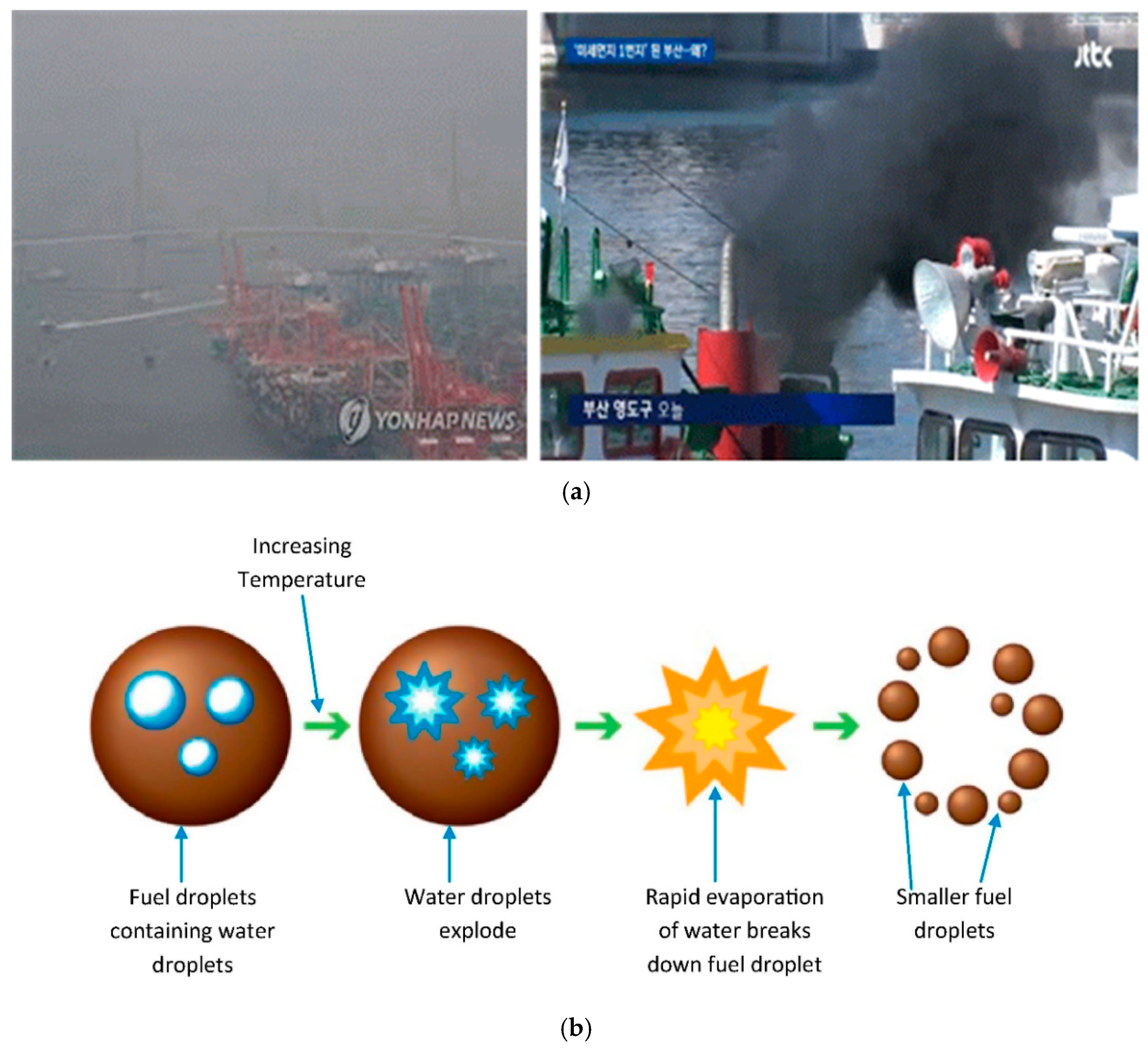

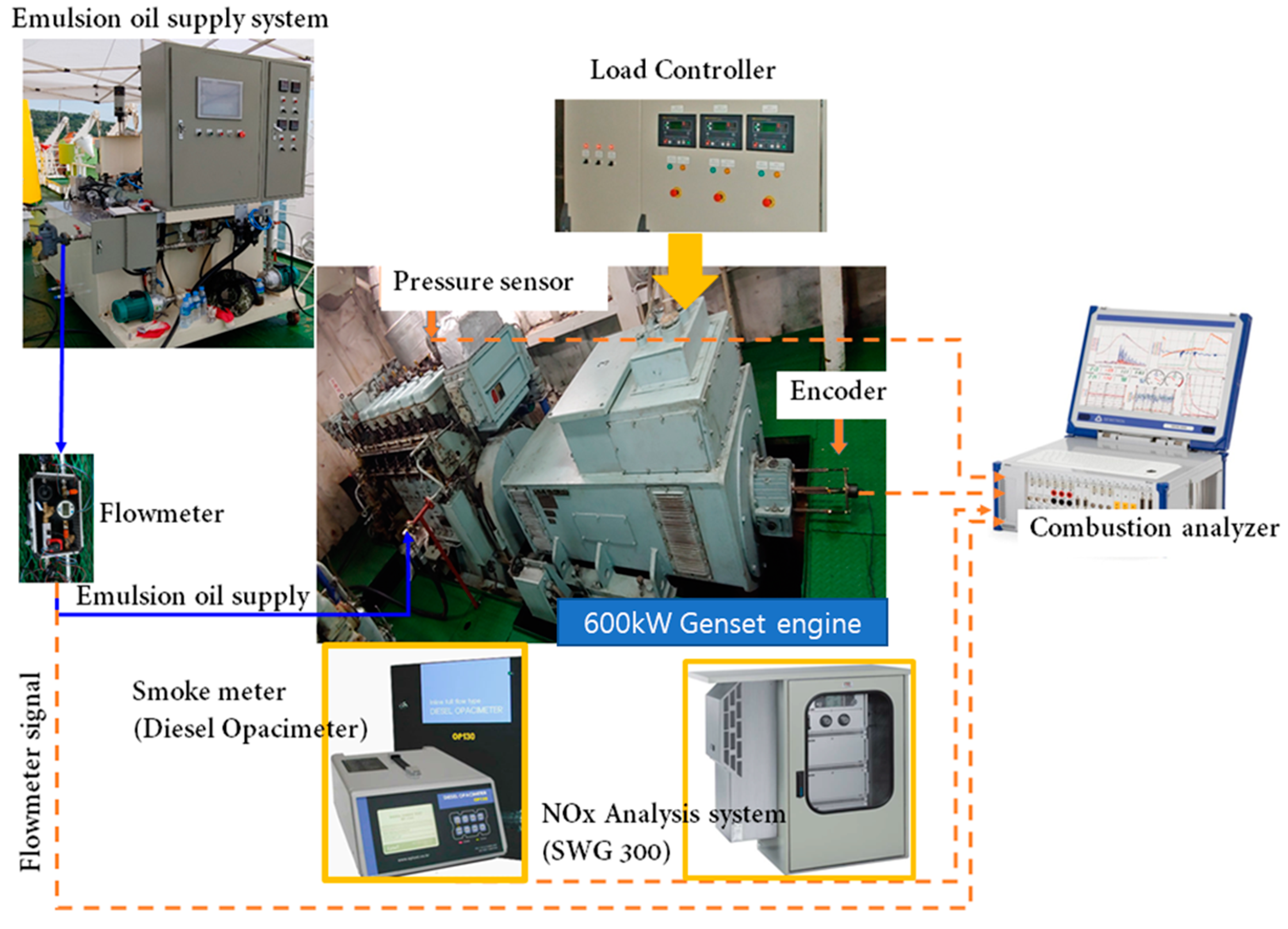
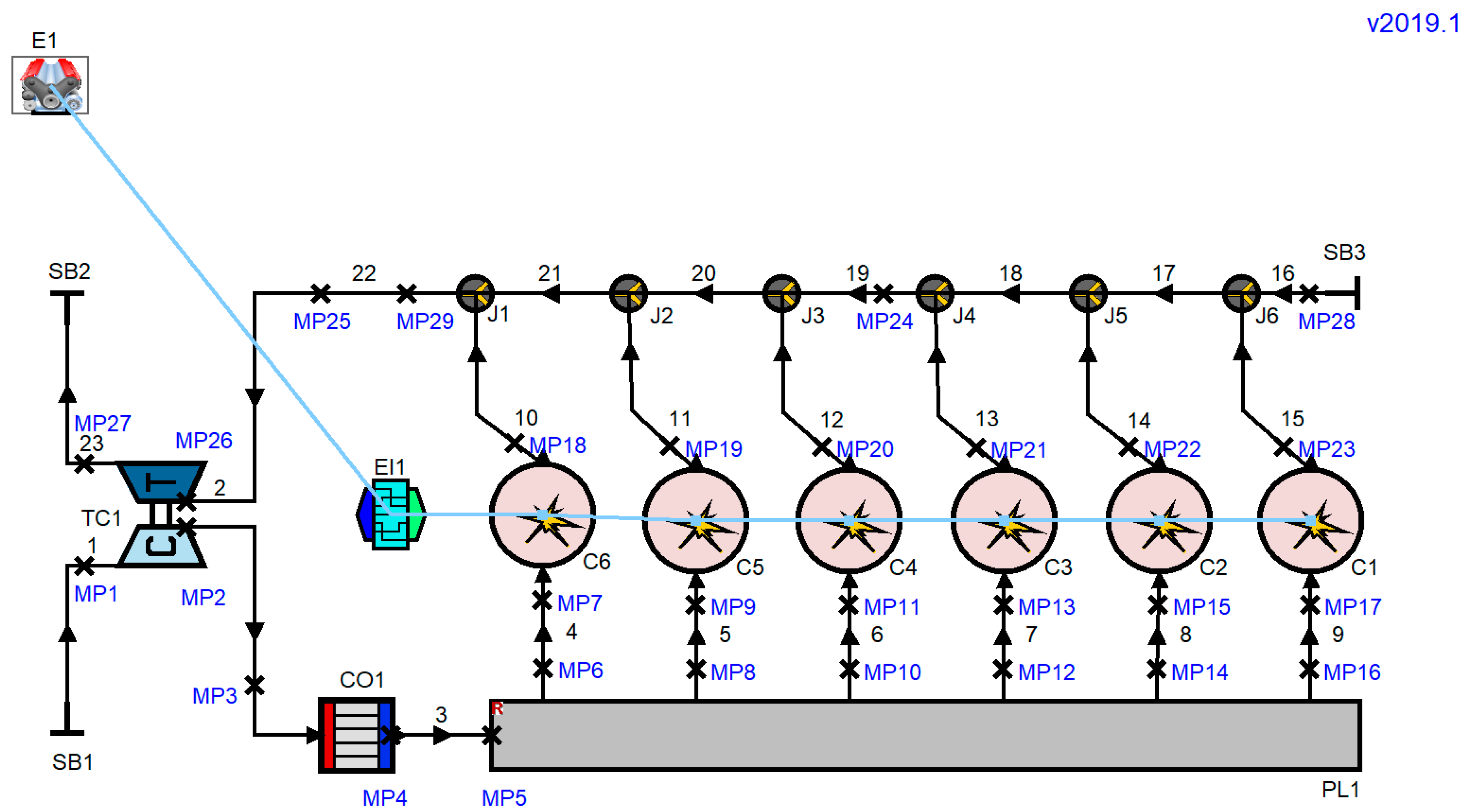
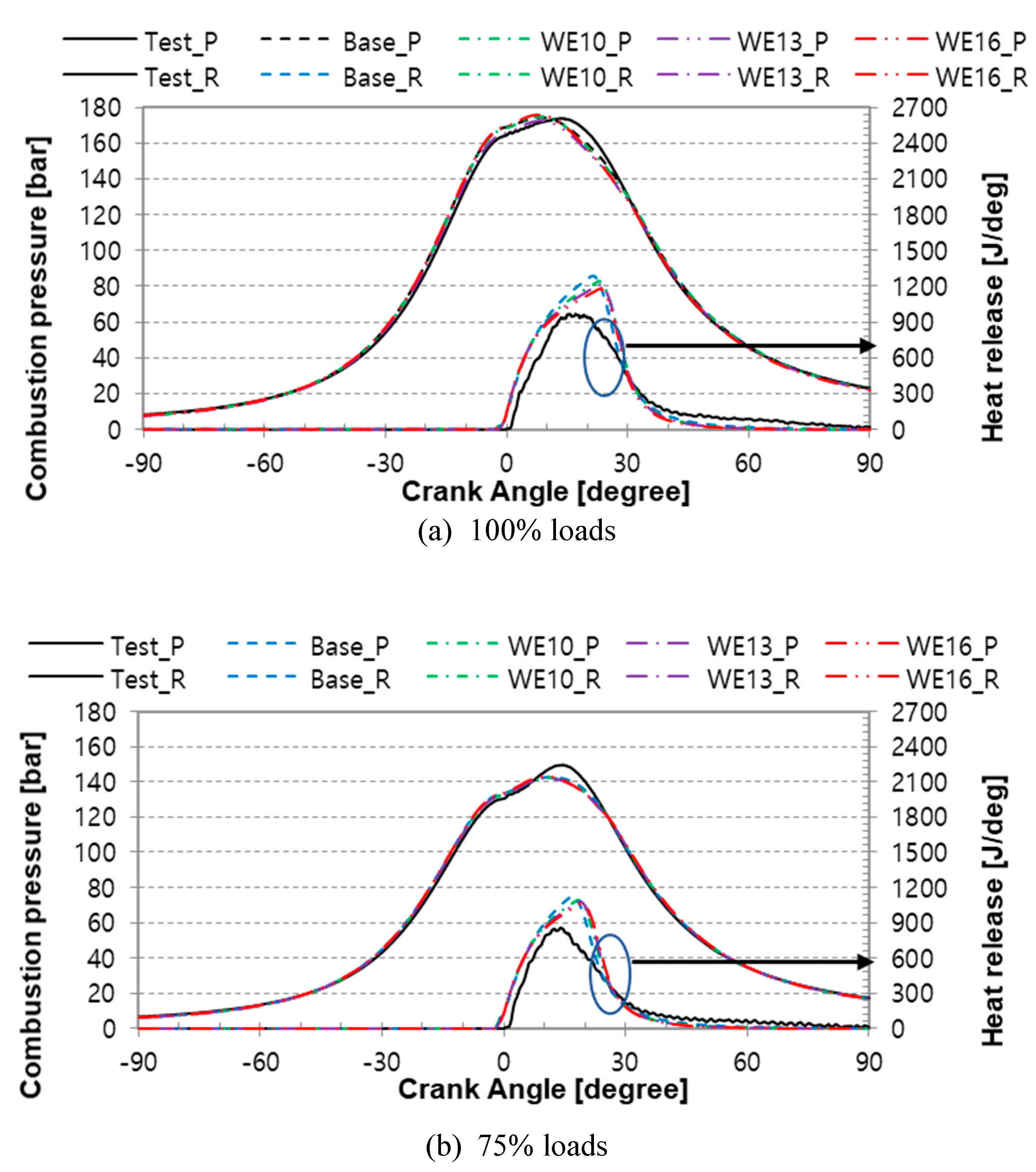








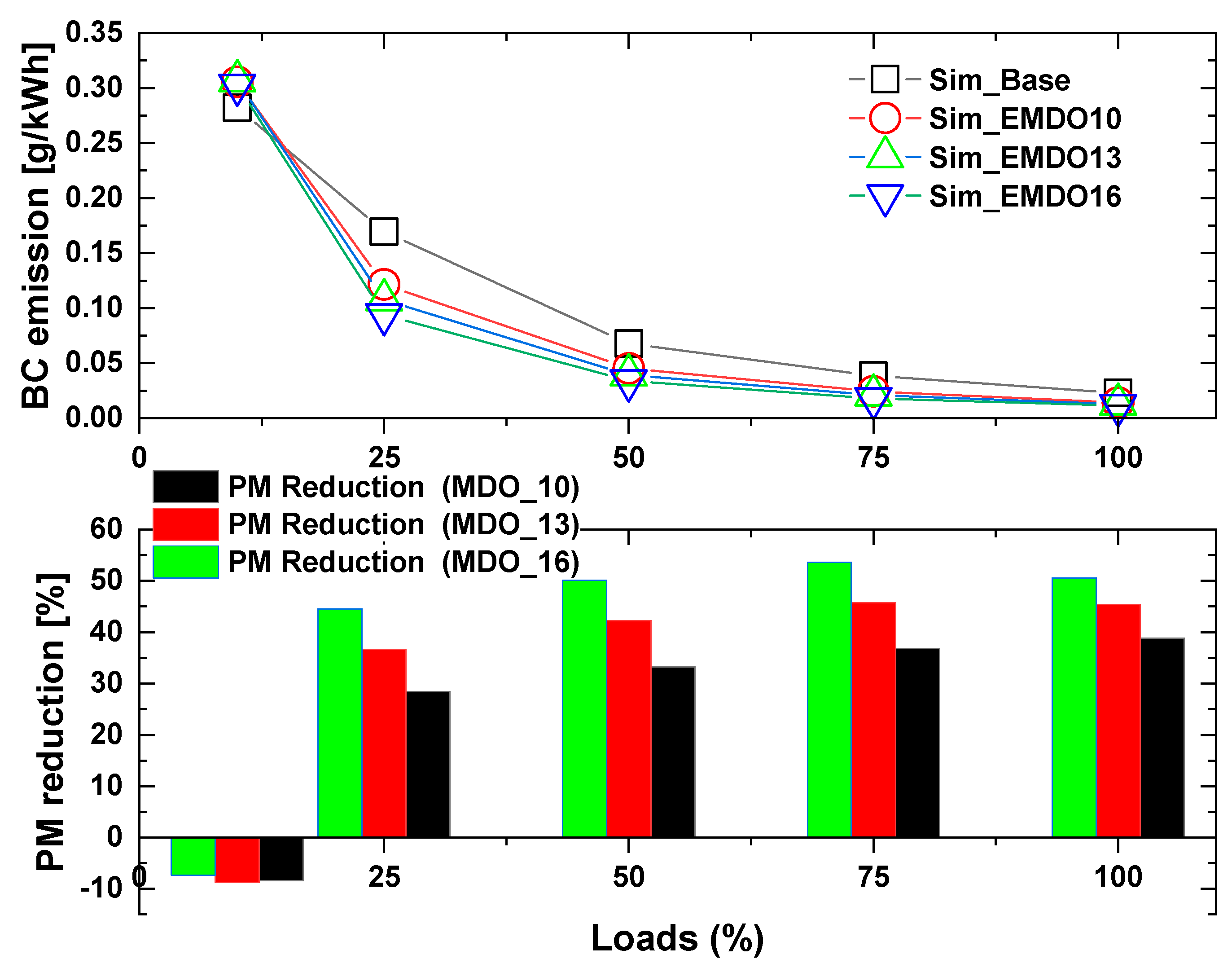
| Abatement Measure | CO2 % Low | mid | high | BC % Low | mid | high | NOx | SOx | Remarks | Reference |
|---|---|---|---|---|---|---|
| Electrostatic precipitators | −5 | nr | nr | 60 | nr | 80 | NOT available | NOT available | Size, commercial availability for ships | [11,12,13,14,15] |
| Diesel Particulate Filters | −1 | −4 | −6 | 70 | 85 | 99 | NOT available | NOT available | Commercial availability for ships. Requires low sulphur fuel | [16,17,18,19,20] |
| Diesel Oxidation Catalyst | nr | nr | nr | nr | 0 | nr | NOT available | NOT available | Often combined with DPF | [18,21,22] |
| Selective Catalytic Reductions | nr | nr | nr | 0 | nr | 35 | Yes | NOT available | [23,24] | |
| Exhaust Gas Recirculation | nr | nr | nr | nr | 0 | nr | Yes | NOT available | May increase BC soot build-up reported | [25,26,27] |
| Scrubbers – Sulphur | −1.5 | −3 | −5 | 20 | nr | 55 | Yes | Yes | Unit cost. Fuel S regulation motivations | [28,29] |
| All Air Emission Parameters | Black Carbon only | Consolidated List |
|---|---|---|
| 1. LNG 2. Water-in-fuel emulsion 3. Scrubbers—high sulphur 4. HFO—distillate 5. Scrubbers—low sulphur 6. Diesel particulate filter 7. Slide valves 8. Slow steaming—de-rating 9. Biodiesel—100% 10. Electrostatic precipitator | 1. LNG 2. Water-in-fuel emulsion 3. Scrubbers—high sulphur 4. Diesel particulate filter 5. HFO—distillate 6. Scrubbers—low sulphur 7. Biodiesel—100% 8. Slide valves 9. Electrostatic precipitator 10. Slow steaming—de-rating | 1. LNG 2. Water-in-fuel emulsion 3. Scrubbers 4. Diesel particulate filter 5. HFO—distillate 6. Slow steaming—de-rating |
| Items/Descriptions | Specifications |
|---|---|
| Engine type | 4-stoke turbo-charged DI marine generator engine |
| Number of cylinders Compression ratio | 6 15.9 |
| Bore × Stroke (mm) | 165 × 265 |
| Displacement (cc) | 20,000 |
| Fuel injection system | Mechanical pumping system (Max. 1400 bar) |
| Engine’s maximum continuous rating (MCR) (kW/rpm) | 600 kW/900 rpm |
| Items | Specification |
|---|---|
| Dynamometer | Load controller (in a marine ship) |
| Exhaust gas analyzer | SWG 300 |
| Smoke meter | Diesel opacimeter (OP 130D) |
| Fuel | MDO, EMDO (10%, 13%, and 16%) |
|---|---|
| Engine speed (rpm) | 900 |
| Load (kW) | 60 (10%), 150(25%), 300 (50%), 450 (75%), 600 (100%) |
| Items/Classifications | MDO | 10% EMDO | 13% EMDO | 16% EMDO |
|---|---|---|---|---|
| Lower calorific value (J/g) | 41,860 | 36,760 | 34,610 | 33,430 |
| Gross calorific value (J/g) | 44,810 | 39,990 | 37,880 | 36,690 |
| Hydrogen (m/m %) | 13.06 | 13.06 | 12.87 | 12.73 |
| Carbon (m/m %) | 85.90 | 79.08 | 77.55 | 78.97 |
| Sulphur content (Weight %) | 0.19 | 0.15 | 0.14 | 0.13 |
| Density @ 20 °C (kg/m3) | 858.9 | 872.3 | 878.5 | 882.3 |
| Moisture (Volume %) | 0.3 | 11.0 | 14.5 | 15.2 |
| Flash point (°C) | 104 | 102 | 114 | 118 |
© 2019 by the authors. Licensee MDPI, Basel, Switzerland. This article is an open access article distributed under the terms and conditions of the Creative Commons Attribution (CC BY) license (http://creativecommons.org/licenses/by/4.0/).
Share and Cite
Choi, I.; Lee, C. Numerical Study on Nitrogen Oxide and Black Carbon Reduction of Marine Diesel Engines Using Emulsified Marine Diesel Oil. Sustainability 2019, 11, 6347. https://doi.org/10.3390/su11226347
Choi I, Lee C. Numerical Study on Nitrogen Oxide and Black Carbon Reduction of Marine Diesel Engines Using Emulsified Marine Diesel Oil. Sustainability. 2019; 11(22):6347. https://doi.org/10.3390/su11226347
Chicago/Turabian StyleChoi, Iksoo, and Changhee Lee. 2019. "Numerical Study on Nitrogen Oxide and Black Carbon Reduction of Marine Diesel Engines Using Emulsified Marine Diesel Oil" Sustainability 11, no. 22: 6347. https://doi.org/10.3390/su11226347
APA StyleChoi, I., & Lee, C. (2019). Numerical Study on Nitrogen Oxide and Black Carbon Reduction of Marine Diesel Engines Using Emulsified Marine Diesel Oil. Sustainability, 11(22), 6347. https://doi.org/10.3390/su11226347





